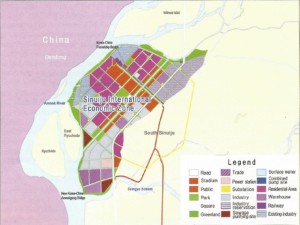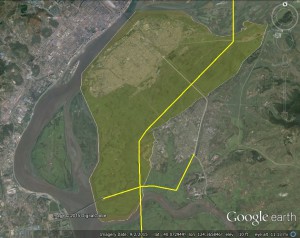UPDATE 5 (2015-12-24): Koreas reach deal on land use fee at Kaesong complex. According to Yonhap:
South and North Korea have reached an agreement on the land use fee amount for South Korean firms operating a joint industrial park across the border, the Unification Ministry announced Thursday.
The deal calls for South Korean firms at Kaesong Industrial Complex to pay US$0.64 per square meter every year, it said.
The complex in the North’s border city of Kaesong opened in 2004 as a symbol of inter-Korean reconciliation. A total of 124 South Korean firms are running factories with about 54,000 North Koreans working in them.
Kaesong has served as a major revenue source for the cash-strapped North, while South Korea has benefited from cheap but skilled North Korean labor.
The South’s firms were exempted from land use fees for a decade under a 2004 deal. The two sides launched talks over the issue again in late 2014.
“The government hopes that the agreement will help South Korean firms focus on their businesses in a stable manner,” said a ministry official, asking not to be named.
The North initially claimed that the South should pay $1 per square meter for all areas that were supposed to be developed under the 2004 agreement, according to an industry source.
But Seoul insisted that it will pay only around half of the North’s offered price for the land that the South’s firms are actually using. They are currently using about 25 percent of the 1 million square meter land.
“The government hopes that the two Koreas could resolve other pending issues related to the operation of the factory zone through dialogue,” the official added.
The operation of the complex has been affected by the ups and downs of inter-Korean ties. In April 2013, the North abruptly suspended the operation of the complex for about five months, citing inter-Korean tensions.
Ending a months-long wage dispute, the two sides agreed in August to raise the minimum wage for the North’s workers by 5 percent to US$73.87 per month.
UPDATE 4 (2015-12-21): North and South Korea cannot agree on land use fees. According to Yonhap:
South and North Korea have been sharply divided over how much South Korean firms operating at a joint industrial park in the North should pay for land use, government officials said Monday.
The two Koreas are in talks over the payment by 124 South Korean firms over land use fees at Kaesong Industrial Complex where about 54,000 North Koreans are working, according to the officials at the Unification Ministry.
The complex in the North’s border city of Kaesong was opened in 2004 as a symbol of inter-Korean reconciliation. It has served as a major revenue source for the cash-strapped North, while South Korea has utilized cheap but skilled North Korean laborers.
The South has been exempted from land use fees for a decade, but the measure is set to expire this year.
The North claims that the South should pay US$1 per square meter for the total land that was supposed to be developed under the 2004 deal, according to an industry source.
But Seoul insists that it would pay around half of the North’s offered price for only the land that the South’s firms are currently using.
“The two sides are seriously involved in talks over the matter,” said a ministry official, declining to elaborate.
On Nov. 4, North Korea denied the entry of two South Koreans to the factory park amid speculation that it may be trying to gain leverage in the talks on the land use fee.
Two days later, the North averted its ban on the entry of the two including a vice chairman of the South’s committee on the inter-Korean facilities.
Ending a months-long wage dispute, the two Koreas agreed in August to raise the minimum wage for the North’s workers by 5 percent to US$73.87 per month.
UPDATE 3 (2015-8-25): Yonhap with additional information on the agreement:
Unification Minister Hong Yong-pyo said Tuesday that an inter-Korean deal struck earlier in the day marks the first time that North Korea had expressed regret over its provocations.
In the agreement, the North “expressed regret” over the recent injury of South Korean soldiers in the explosion of land mines laid by North Korea in the Demilitarized Zone (DMZ) separating the two Koreas.
“It is the first time that the North offered an apology and expressed regret after using the subject of North Korea (in its statement),” Hong said at the ruling Saenuri Party’s workshop.
“The biggest strength that led to this meaningful agreement was that the people stayed together,” Hong said.
The South also technically secured the North’s promise not to repeat such an attack, putting a clause into the deal that it will resume loudspeaker propaganda broadcasts along the DMZ if an “abnormal case” occurs.
“When North Korea did not show responsibility or demanded something unfair during the course of the dialogue and the negotiation, I mostly used a phrase that said ‘the people are watching,'” Hong said.
UPDATE 2 (2015-8-25): South Korean business community welcomes deal. According to Yonhap:
South Korea’s business community welcomed a landmark deal Tuesday on defusing inter-Korean tensions, pledging to rev up efforts to expand economic ties with North Korea.
After days of intensive high-level talks, the Koreas agreed to ease tensions sparked by Pyongyang’s landmine attack that injured two South Korean soldiers early this month.
Calling the agreement a great relief, the Federation of Korean Industries (FKI), the lobby for South Korea’s family-run conglomerates, said it will push ahead with overall plans for boosting economic cooperation with North Korea
“North Korea’s latest provocations were a source of concern because they could hamper inter-Korean economic cooperation,” an FKI official said. “We are greatly relieved at the news.”
Although it’s unlikely that Seoul-Pyongyang economic cooperation will make immediate headway, the FKI will gradually go ahead with the necessary steps, including the establishment of economic offices in the capitals of both Koreas, he added.
The agreement also came as good news to South Korean firms currently doing business at the inter-Korean industrial complex in the North Korean border town of Kaesong.
“The firms underwent a lot of troubles amid the worsened relations between the two Koreas, so (now that they have reached a deal,) we are hoping for improved business conditions down the road,” said Jeong Gi-seob, chairman of the association of 124 South Korean small and medium-sized companies operating at the zone.
The South Korean companies operate factories at the industrial park, the last remaining symbol of inter-Korean reconciliation, employing about 54,000 North Korean workers.
The Korea Chamber of Commerce and Industry (KCCI) also promised to play its part in promoting economic relations with the North following the latest agreement.
“The business community will redouble efforts to lay the practical groundwork for the mutual development of the two Koreas,” a KCCI official said. “We also hope that a thaw in inter-Korean relations will lead to more exchange as well as the normalization of economic ties.”
UPDATE 1 (2015-8-24): The North and South Koreans have agreed to a solution to the situation. According to KCNA via Yonhap:
1. The north and the south agreed to hold talks between their authorities in Pyongyang or Seoul at an early date to improve the north-south ties and have multi-faceted dialogue and negotiations in the future.
2. The north side expressed regret over the recent mine explosion that occurred in the south side’s area of the Demilitarized Zone (DMZ) along the Military Demarcation Line (MDL), wounding soldiers of the south side.
3. The south side will stop all loudspeaker propaganda broadcasts along the MDL from 12:00, August 25 unless an abnormal case occurs.
4. The north side will lift the semi-war state at that time.
5. The north and the south agreed to arrange reunions of separated families and relatives from the north and the south on the occasion of the Harvest Moon Day this year and continue to hold such reunions in the future, too and to have a Red Cross working contact for it early in September.
6. The north and the south agreed to vitalize NGO exchanges in various fields.
ORIGINAL POST (2015-8-20): The two Korea’s literally just finished hammering out a new agreement on “wages” for North Korean workers at the Kaesong Industrial Complex. However, with the ink barely dried, a new round of escalating conflict between the Koreas is affecting operations at the KIC…
According to Yonhap:
South Korea said Friday it will limit the entry of its nationals into a joint industrial park in North Korea following the exchange of artillery fire between the two sides.
The Unification Ministry said it will only permit South Korean businessmen directly involved in the operation of factories at the Kaesong Industrial Park to enter the complex.
But other South Koreans, including those working at subcontractors, will not be allowed to move in and out of the complex in the North’s border city of the same name, the ministry said.
South Korea fired back at North Korea on Thursday following the North’s firing of shells at a South Korean front-line military unit in the western area of the heavily fortified border. No damage was reported.
A total of 124 South Korean small and medium-size enterprises operate factories at the industrial park, the last remaining symbol of inter-Korean reconciliation. About 54,000 North Koreans work there.
South Korean businessmen safely returned to the South from the complex on Thursday despite the North’s provocation.
The ministry said it has taken measures to ensure the safety of South Koreans who are temporarily staying in the North.
Read the full story here:
S. Korea to partially ban entry into joint industrial park
Yonhap
2015-8-20


